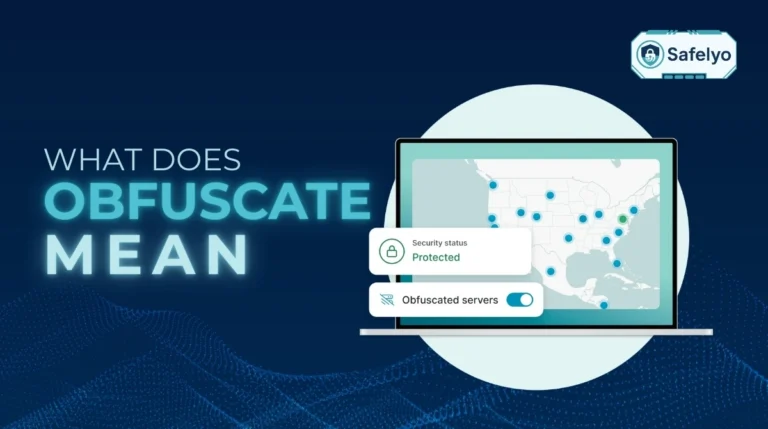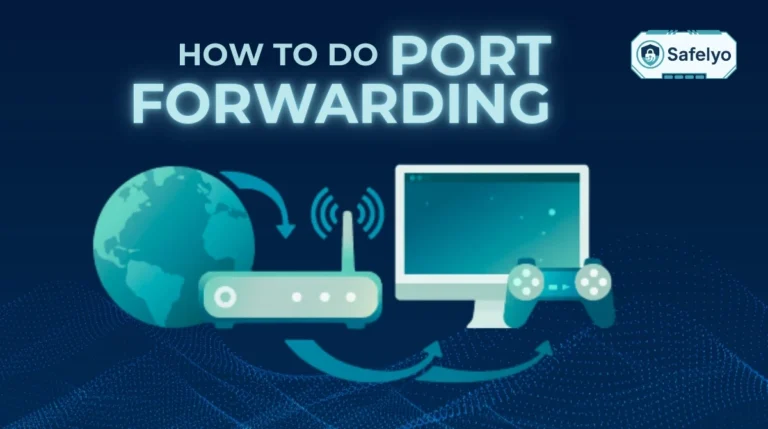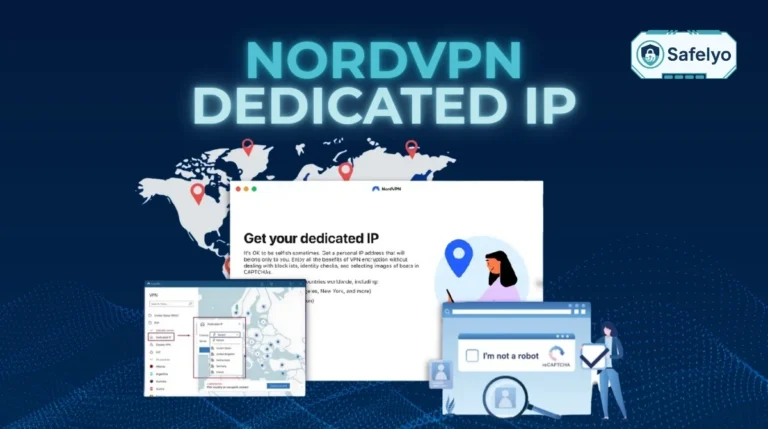When choosing security tools, you’ll often see two options: AES-128 and AES-256. What is AES-128 encryption? And what is the AES-256? Think of them as choosing between a 10-foot-thick steel vault door and a 14-foot-thick one. While one is technically thicker, both are fundamentally unbreakable for any practical purpose.
In the world of digital security, this choice can cause unnecessary anxiety. Does a bigger number mean you’re significantly safer? Is the smaller one a risky compromise?
Having spent over a decade testing VPNs and encryption protocols, I’ve seen this question confuse even tech-savvy users. The truth is, the real threats to your data rarely involve breaking the encryption itself. This AES-128 vs AES-256 comparison is here to shift your focus from abstract numbers to practical, real-world security.
In this comprehensive guide, you’ll discover:
- The simple, real-world difference between these two standards.
- Why AES-128 is more than secure enough for your daily activities.
- The actual trade-offs in performance and speed.
- How to choose the right encryption for your specific needs.
Don’t let technical jargon dictate your security choices. Let me provide the clarity you need to stay both fast and secure online.
AES-128 vs. AES-256: The Bottom Line
Both AES-128 and AES-256 are extremely secure and considered unbreakable by today’s technology. AES-256 offers a higher theoretical security level (a longer key) and is the standard for top-secret data. AES-128 is slightly faster, though the difference is negligible on modern devices.
You can’t go wrong with either. For most users, the default setting (usually AES-256) provided by security apps is the best and simplest choice.
1. Understanding AES key size: What is AES-128 encryption?
To really grasp the difference between AES-128 and AES-256, let’s stop thinking about code and start thinking about a bank vault. In my experience, it’s the clearest way to explain this concept without getting lost in complex mathematics.
The Advanced Encryption Standard (AES) is akin to a cutting-edge bank vault door, designed to safeguard your most valuable assets. It’s a globally trusted, standardized design. Whether you choose 128 or 256, you’re getting the same incredibly strong and reliable door.
The number – 128 or 256 – refers to the length of the secret key, which is like the combination for the vault’s lock. A longer key simply means a more complex combination.
- AES-128 is a 10-round combination lock. The number of possible combinations is so vast (2¹²⁸) that the fastest supercomputer on earth would need billions of years to guess it. For all practical purposes, it is unbreakable by any known means today.
- AES-256 is the same vault door, but with a 14-round combination lock. It doesn’t make the door itself stronger against, say, an explosion, but it makes the combination even more astronomically difficult to guess (2²⁵⁶ possibilities). This is the standard for protecting top-secret government data.
Here’s the most important takeaway from my years in this field: The weak link is almost never the encryption algorithm itself. An attacker is far more likely to trick you with a phishing email or exploit a weak password than to even attempt to break the vault door. Both AES-128 and AES-256 are more than strong enough; your real security focus should be on how the keys are managed and your overall digital habits.
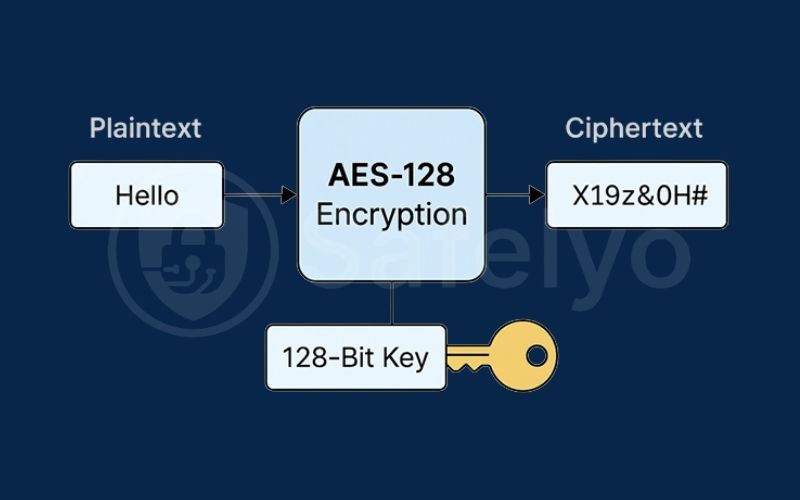
2. The showdown: AES-128 vs. AES-256 compared
The bank vault analogy gives us a great mental model. Now, let’s line up the technical specifications side-by-side. When I’m analyzing a new VPN service or security app for Safelyo, this is essentially the checklist I run through in my head to separate marketing hype from real-world performance. This table cuts straight to the chase.
| Feature | AES-128 | AES-256 |
| Key Size | 128 bits | 256 bits |
| Encryption Rounds | 10 rounds of processing | 14 rounds of processing |
| Security Level | Extremely Secure (unbreakable today) | Even More Secure (future-proof & quantum-resistant) |
| Performance / Speed | Faster (requires less processing power) | Slightly Slower (requires more processing power) |
| Resource Usage | Lower (less impact on CPU and battery) | Slightly Higher (more impact on CPU and battery) |
| Common Use Cases | Most commercial software, VPNs, and Wi-Fi | Top-secret government files, ultra-sensitive financial data |
As you can see, the main trade-off is between a slight performance advantage with AES-128 versus the ultimate, future-proof security standard of AES-256. The key question now becomes: Is that extra security from AES-256 something you actually need? Let’s dive into that next.
3. Security: Is AES-128 secure enough?
Let me answer this directly: Yes, absolutely. For any conceivable threat you will face as a regular internet user, AES-128 is more than secure enough. It’s not just “good encryption”. It’s a world-class security standard that is, for all practical purposes, unbreakable.
3.1. The brute-force reality
When security experts talk about “breaking” encryption, they’re often referring to a brute-force attack – trying every single possible key until the right one is found.
So, what is the AES-128 crack time? To understand the enormity of 2¹²⁸, even the world’s supercomputers combined would take billions of years to break just one AES-128 key. It is simply not a practical threat. The energy required to run those computers for that long would exceed the total energy output of the sun.
3.2. The real threats you should focus on
In my experience analyzing cybersecurity incidents, I have never once seen a case where a hacker broke AES encryption. The attacks are always simpler and target the weakest link: You. Hackers are far more likely to get your data through:
- Phishing scams: Tricking you into giving them your password.
- Weak passwords: Using common or reused passwords that are easy to guess.
- Malware: Infecting your device to steal information before it even gets encrypted.
Worrying about AES-128 vs. AES-256 is like ensuring your vault door is indestructible while leaving the key under the doormat.
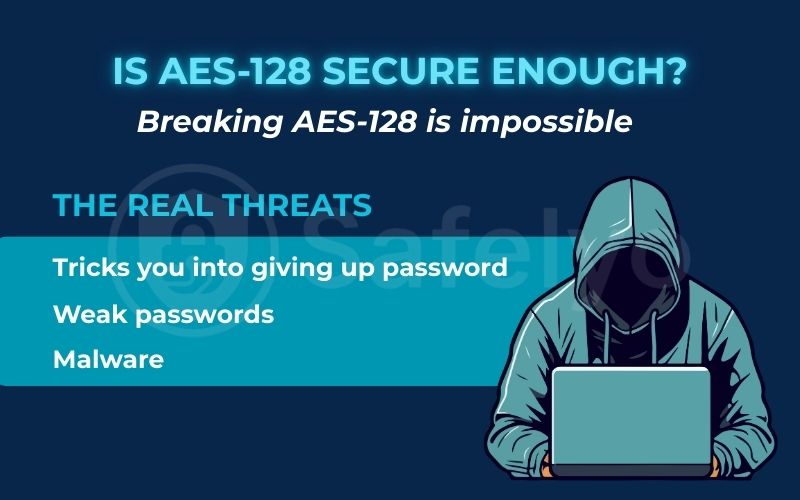
3.3. So why does AES-256 exist?
If AES-128 is already unbreakable, why bother with the bigger number? There are two main reasons:
- Future-proofing: AES-256 provides an even larger security margin against theoretical future threats, most notably the development of powerful quantum computers that could potentially speed up brute-force attacks.
- Compliance and standards: It’s the required standard for organizations like the U.S. government when handling top-secret information.
When I’m asked, “Which is better, AES-128 or AES-256?” from a pure security standpoint, the answer is 256. But in practice, it’s like asking if a 10-foot-thick steel wall is “better” than a 14-foot-thick one for stopping a paper airplane. Both are overkill in the best way possible.
4. Performance: AES-128 vs. AES-256 speed and overhead
Now that we’ve established both standards are Fort Knox-level secure, let’s talk about the one area where there is a measurable difference: Performance.
The main practical distinction in the AES-128 vs AES-256 speed debate comes down to the number of rounds. Because it has fewer encryption rounds to process (10 vs. 14), AES-128 is technically faster. In benchmark tests that isolate pure cryptographic operations, AES-128 can be up to 40% faster than AES-256.
But here’s the multi-million dollar question: Does this matter for you?
On modern devices, the difference is almost zero.
For most of us using modern PCs, Macs, and smartphones, this speed difference is purely academic. The reason is a bit of hardware magic called AES-NI (Advanced Encryption Standard New Instructions). This is a dedicated set of instructions built directly into modern processors (like Intel and AMD) specifically to accelerate AES encryption and decryption.
From my own real-world testing, I can tell you this: when I run speed tests on a top-tier VPN, I cannot detect a meaningful difference between its AES-128 and AES-256 connections on my laptop or phone. My internet connection speed is always the bottleneck, long before the encryption ever is. You are far more likely to notice a slowdown from a weak Wi-Fi signal than from using AES-256.
Where the performance difference might matter
The performance gap can become relevant in resource-constrained environments. Think of devices with less processing power, such as:
- Small IoT (Internet of Things) devices like smart sensors.
- Older, less powerful internet routers.
- Small embedded systems where every CPU cycle and every drop of battery life counts.
In these specific cases, the lower AES-256 overhead (the extra computational work required) makes AES-128 a more efficient choice. But for your primary devices, this overhead is so well-optimized by modern hardware that it’s rarely a deciding factor for consumers.
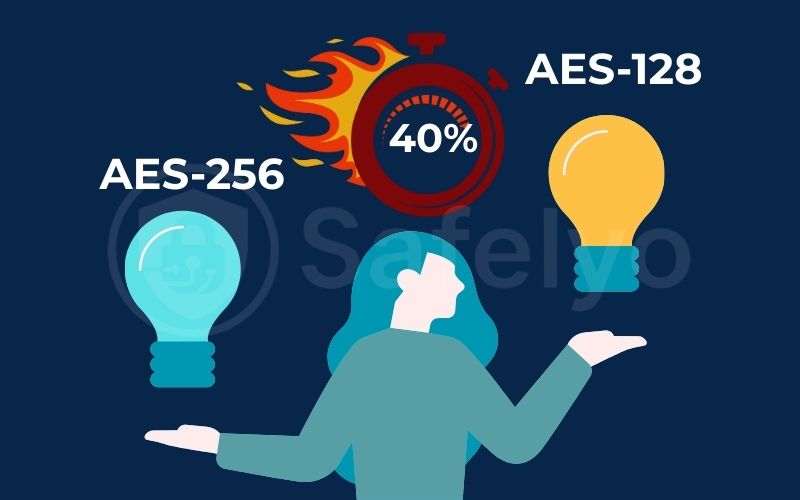
Read more:
5. Safelyo’s decision guide: Should I use AES-256?
We’ve addressed the aspects of theory, security, and performance. Now, let’s make this simple. I’ve built this decision guide based on the same advice I give to friends and family when they ask me for help setting up their digital security. Find your priority in the table below to get a straightforward recommendation.
| If your priority is… | The best choice is… | Why? |
| Maximum speed for gaming/streaming | AES-128 (if your VPN offers it as an option) | It offers a slight, though often unnoticeable, performance edge with security that is already unbreakable for all practical purposes. |
| Ultimate, future-proof security | AES-256 | It’s the benchmark for safeguarding extremely confidential information. Choose this for absolute peace of mind against all current and theoretical future threats. |
| General VPN use (browsing, etc.) | “Automatic” or the default (usually AES-256) | Top VPN providers default to AES-256, and their networks are highly optimized for it. The speed difference is minimal, so just stick with the default. |
| Using an older, slower device | AES-128 | If you’re setting up a VPN on an old router or a less powerful device, you might notice a small but welcome performance boost with AES-128. |
In general, it’s best for most people to stick with the default settings provided by your trusted security app regarding AES-256. This approach is the safest option. While side-channel attacks (which analyze things like power consumption or sound to infer information about the key) are a theoretical risk in a controlled lab setting, they are not a practical threat to the average user of a well-implemented security product. These companies have already optimized their software for the best balance of security and performance. Don’t feel pressured to change it unless you have a very specific reason, like squeezing every last bit of speed out for a competitive gaming session.
What does “military-grade” really mean?
You’ll often see VPNs and other security products advertise “military-grade” encryption. This term is marketing shorthand that typically refers to AES-256. However, it’s important to know that the U.S. government actually uses both AES-128 for ‘Secret’ information and AES-256 for ‘Top Secret’ information.
This proves that even AES-128 meets an incredibly high security standard trusted by intelligence agencies worldwide. When you see a service using either standard, you can be confident you’re getting world-class protection.
6. FAQ about the AES-128 encryption
We’ve covered the details, but you might still have some specific questions. Here are quick, direct answers to the most common queries we see about AES encryption.
What is AES-128 encryption?
AES-128 is a highly secure, globally recognized standard for data encryption. It is a symmetric key algorithm that uses a 128-bit key to scramble and unscramble data in 128-bit blocks. It’s widely used to protect information in countless applications.
Is AES-128 secure in 2025?
Yes, absolutely. AES-128 remains computationally secure and is considered unbreakable by any publicly known technology, including the most powerful supercomputers. For all practical purposes, it provides more than enough security for your data today and for the foreseeable future.
Which is better, AES-128 or 256?
From a purely technical standpoint, AES-256 is stronger due to its longer key and more encryption rounds. However, in the real world, AES-128 is already unbreakable. The choice isn’t about “good vs. bad” but rather a trade-off: AES-128 offers slightly better performance, while AES-256 provides the maximum level of future-proof security.
What is AES-128 used for?
You encounter AES-128 every day. It’s commonly used to secure Wi-Fi networks (WPA2/WPA3), HTTPS connections that protect your web browsing, VPN tunnels, file encryption on your hard drive, and countless commercial software applications.
Do most VPNs use AES-128 or AES-256?
Most premium VPN providers default to using AES-256, often pairing it with secure protocols like OpenVPN or WireGuard.They implement this strategy to showcase their top-tier security measures. Some services offer AES-128 as an option for users who want to prioritize speed.
Can AES be hacked through side-channel attacks?
Side-channel attacks analyze things like power consumption or sound. They infer information about the key. These attacks are a theoretical risk in a controlled lab setting. However, they are not a practical threat to the average user. This is especially true for those using well-implemented security products.
7. Conclusion
The debate of AES-128 vs AES-256 is often more academic than practical. Choosing between them is not a choice between a weak option and a strong one; it’s a choice between two incredibly powerful security standards. Your online safety will not be compromised by picking one over the other.
Key takeaways:
- Both AES-128 and AES-256 are unbreakable by today’s technology.
- AES-128 is slightly faster, which can be a minor benefit on older devices.
- AES-256 is the gold standard for ultimate security, offering future-proof protection against emerging threats.
- For most users, the default setting in your VPN or security app (usually AES-256) is the best and simplest choice.
Don’t let the numbers cause unnecessary anxiety. By selecting a product that uses either AES-128 or AES-256, you’re already using one of the most secure encryption standards on the planet.
At Safelyo, we only recommend products that meet these high standards. To see how top providers use this powerful technology, explore our reviews of the best VPNs in our Privacy & Security Basics section.


